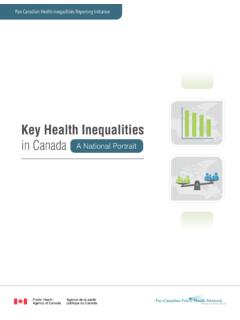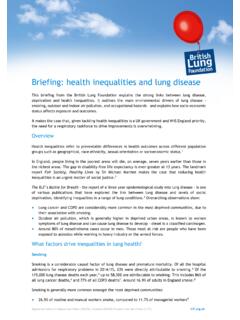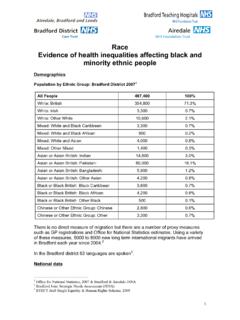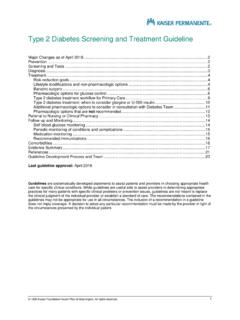Transcription of Local authorities improving oral health: commissioning ...
1 Local authorities improving oral health : commissioning better oral health for children and young people An evidence-informed toolkit for Local authorities commissioning better oral health for children and young people About Public health England Public health England's mission is to protect and improve the nation's health and to address inequalities through working with national and Local government, the NHS, industry and the voluntary and community sector. PHE is an operationally autonomous executive agency of the Department of health . Public health England 133-155 Waterloo Road Wellington House London SE1 8UG. Tel: 020 7654 8000. @PHE_uk For queries relating to this document, please contact: Jenny Godson; email: Crown Copyright 2013.
2 You may re-use this information (excluding logos) free of charge in any format or medium, under the terms of the Open Government Licence To view this licence, visit OGL or email Where we have identified any third party copyright information you will need to obtain permission from the copyright holders concerned. Published June 2014. PHE gateway number: 2014147. This document is available in other formats on request. Please call 020 8327 7018. or email 2. commissioning better oral health for children and young people Contents About Public health England 2. Contents 3. Foreword 4. Executive summary 5. Section 1: Introduction 9. Section 2. Principles of commissioning better oral health for children and young people 18. Section 3. commissioning across the life course: what works?
3 24. Section 4. Supporting commissioners what does this mean for commissioning ? 37. Section 5. Making commissioning choices what does good look like? 44. Appendix 1. Ten key questions to ask - improving the oral health of children and young people 60. Local authorities ' public health role 60. Acknowledgements 61. References 63. 3. commissioning better oral health for children and young people Foreword It is well recognised that oral health is an important part of general health and wellbeing. Whilst there have been welcome improvements in the oral health of children in England, significant inequalities remain. The health and Social Care Act (2012) conferred the responsibility for health improvement, including oral health improvement to Local authorities .
4 This document aims to describe these new responsibilities and to provide support for Local authorities in their delivery. It includes information to enable the review and evaluation of current commissions and the integration of evidence-informed programmes within existing programmes for children and young people. Many general health conditions and oral diseases share common risk factors such as smoking, alcohol misuse and poor diet. oral diseases are largely preventable; and there is a need to develop interventions to achieve sustained and long-term improvements in oral health and reduce inequalities . To do so, requires partnership action to address the wider determinants of health , ranging from economic and social policy change (creating healthier environments), to the adoption of healthier behaviours by individuals in the population.
5 We recognise that it is fundamentally important to focus also on upstream factors that create inequalities and that cause both poor general and oral health . Public health England is pleased to provide this guide, we thank the multidisciplinary steering group and advisers who supported its development. Kevin Fenton, Director of health and Wellbeing Sue Gregory, National Head of Dental Public health Public health England 4. commissioning better oral health for children and young people Executive summary What responsibilities do Local authorities have for improving the oral health of children and young people? Local authorities are statutorily required to provide or commission oral health promotion programmes to improve the health of the Local population, to an extent that they consider appropriate in their areas.
6 They are also required to provide or commission oral health surveys. The oral health surveys are carried out as part of the Public health England (PHE) dental public health intelligence programme (formerly known as the national dental epidemiology programme). Why is children's and young people's oral health important? Tooth decay is the most common oral disease affecting children and young people (CYP) in England, yet it is largely preventable. While children's oral health has improved over the past 20 years, almost a third ( ) of five-year- olds still had tooth decay in 2012. Poor oral health impacts children and families' health and wellbeing. Children who have toothache or who need treatment may have to be absent from school. Parents may also have to take time off work to take their children to the dentist.
7 oral health is an integral part of overall health ; when children are not healthy, this affects their ability to learn, thrive and develop. Good oral health can contribute to school readiness. Tooth decay was the most common reason for hospital admissions in children aged five to nine years old in 2012-13. Dental treatment under general anaesthesia (GA), presents a small but real risk of life-threatening complications for children. Dental treatment is a significant cost, with the NHS in England spending billion per year on dental care (with an estimated additional billion on private dental care). 5. commissioning better oral health for children and young people Are there oral health inequalities ? People living in deprived communities consistently have poorer oral health than people living in richer communities.
8 Stark regional differences also exist. For example in 2012, of five-year-olds had tooth decay in South East England compared to in the North West of England, with even greater inequalities within Local authority areas. What are the policy drivers? The government made a commitment to oral health and dentistry with a drive to: improve the oral health of the population, particularly children introduce a new NHS primary dental care contract increase access to primary care dental services The public health outcomes framework (2013-16) includes tooth decay in five- year-old children as an outcome indicator. The NHS outcomes framework (2014-15) includes indicators related to patients'. experiences of NHS dental services and access to NHS dental services.
9 The Children and Young People's health Outcomes Forum report published in 2012 and its 2014 annual report recommended improved integration and greater action to reduce regional variation in child health outcomes. What can we do to improve oral health outcomes for children and young people and reduce oral health inequalities ? Put children and young people (CYP) and their families at the heart of commissioning . Adopt an integrated approach with partners for oral health improvement (see Table ), including NHS England, Public health England and Clinical commissioning Groups. Ensuring all Local authority services for CYP have oral health improvement embedded at a strategic and operational level. Commission for oral health improvement across the life course, giving every child the best start in life and adopting the principle of proportionate universalism.
10 Address the underlying causes of health inequalities and the causes of poor general and oral health though upstream evidence informed actions. Use, share and develop information and intelligence. 6. commissioning better oral health for children and young people Sustain and develop the CYP workforce. Support CYP through their families, early years, schools and community settings to maintain good oral health , adopting a place based approach. Lead and advocate a clear Local vision for oral health improvement and addressing oral health inequalities . Provide access to quality Local dental services focused on improving oral health . What does good commissioning look like? commissioning frameworks should ensure that oral health improvement is integrated within existing programmes such as the healthy child programme for 0 to 19-year olds.














